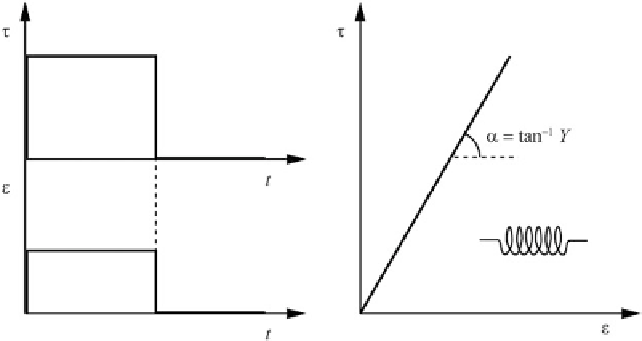Geology Reference
In-Depth Information
physical state, may
flow
under certain thermo-
mechanical conditions, showing a mechanical
behaviour typical of liquids, gases and plasma. In
this instance, a material is subject to continuous
deformation under an applied
shear
stress.
An understanding of the different rheological
behaviors within the solid Earth is fundamental
in geology in general, but particularly in
plate tectonics, where the different interacting
subsystems of crust and mantle display distinct
mechanical behaviors. The simplest constitutive
equation is that associated with the
elastic
behavior
, which approximates adequately the
relationship between stress and strain in solids
at low pressure and temperature and for small
deformations, but also in non-solids in the case
of high-frequency variations of the stress field.
For example, the lithosphere can be considered
as an elastic body in so far as it is not subducted,
but also lower mantle rocks and the outer core,
which is liquid, can be modelled as elastic bodies
at the frequency of deformations associated
with earthquakes. A paradigm for this kind of
mechanical behavior is given by
springs
.Inthis
instance, the constitutive equation expressing the
relation between stress and strain is
Hooke's law
:
¡
@
2
u
i
@£
ij
@x
j
D
0
@t
2
(7.51)
ing equation for the propagation of seismic waves
outside source regions.
7.4
Basic Rheological Models
and Constitutive Equations
Apart from being in one of the four ordinary
states of matter
, solid, liquid, gas, or plasma, a
material has a mechanical behaviour that depends
from its
rheology
. By “mechanical behaviour”,
we mean a distinct relationship between the stress
and strain fields within a body, which can be
expressed by a
constitutive equation
:
R.©;
©;
©;:::;£;
£;
£;:::;
m
1
;m
2
;:::;s
1
;s
2
;:::/
D
0
(7.52)
The function
R
is referred to as the
rheological
function
and usually includes a set of
intrinsic
parameters m
i
that depend from the material
(e.g., elastic moduli, viscosity) and a set of
state
variables s
j
describing the microstructural state
of the material (e.g., grain size, see Ranalli
1995
).
The word “Rheology” originates from Greek and
means “study of flow”. A good quantitative in-
troduction to this subject can be found in Ranalli
(
1995
). Many materials display proportionality
between stress and strain for small deformations.
However,
all
materials, independently from their
£.t/
D
Y©.t/
(7.53)
where
t
is the time and the parameter
Y
,which
depends from the material, is known as the
time
-
independent elastic modulus
. Figure
7.9
shows
the ideal response of an elastic system to a stress
step.
Fig. 7.9
Response of an
elastic system to a stress
step. There is instantaneous
response, linear
proportionality between
stress and strain, and the
strain
©
is fully recoverable
after stress removal




